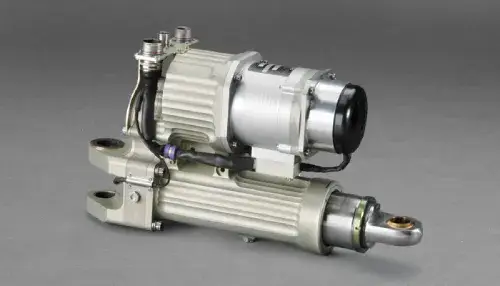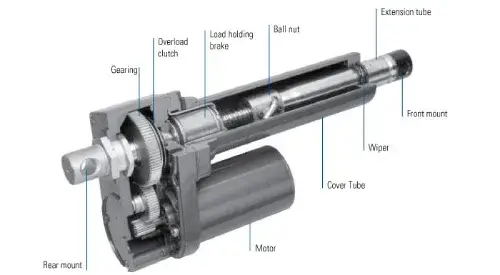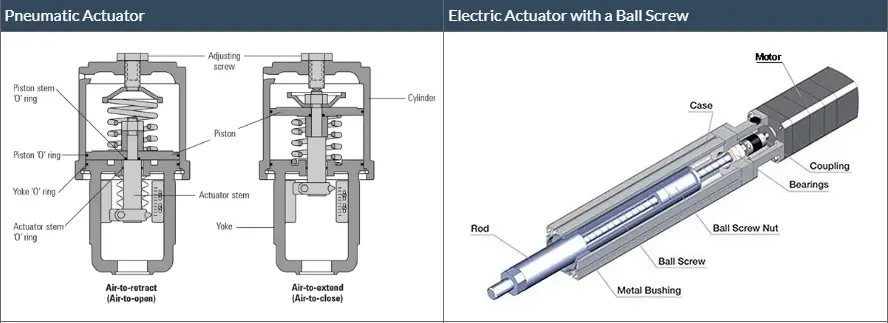

What are Mechanical Actuators
Catalog
What's a Mechanical Actuator?How Does a Mechanical Actuator Work?Design of a Mechanical ActuatorMechanical Actuator TypesDesignAdvantages and DisadvantagesApplicationsFrequently Ask QuestionsRelated ArticlesIn electrical machines, an actuator is a super important part that helps move and control stuff. It uses an energy source and a control device, usually a valve. When the control device gets a signal, the actuator quickly turns the energy into motion. There are lots of types of actuators, like soft, hydraulic, pneumatic, electric, thermal/magnetic, and mechanical. This here is about mechanical actuators and what they do.
What's a Mechanical Actuator?
A mechanical actuator is a device that uses a power source to make things move. These are super important and you can find them in almost every automated machine. The power sources can be electricity, air pressure, or liquid pressure. They can be controlled by hand or by a machine. The main job of a mechanical actuator is to turn spinning motion into straight-line motion. There are different kinds, like lead screws, ball screws, rack and pinion, and belt-driven actuators. The picture below shows a mechanical actuator.
How Does a Mechanical Actuator Work?

Mechanical Actuator
A mechanical actuator works by turning spinning motion into straight-line motion to move stuff around. It mainly uses parts like rails, gears, chains, and pulleys to do this.
Design of a Mechanical Actuator
A mechanical actuator is made up of different parts, with the main ones being the motor, gears, screw, and extension tube. These parts work together to turn spinning motion into straight-line motion.

Design of a Mechanical Actuator
Motor
The motor in this actuator is a DC motor. It makes all the power the actuator needs.
Gears
The gears, made of plastic or steel, change how fast the spinning motion is. They connect directly to the power source, like the motor.
Screw
This actuator uses a screw to work. When you turn the nut, the screw shaft moves in a straight line.
Extension Tube
The extension tube, also called the inner tube, is usually made of stainless steel or aluminum. It connects to the threaded nut and moves in or out as the nut turns along the spinning shaft.
When the motor in the actuator gets power, it spins the gears. This makes more power and slows down the motor. The spinning gears move the screw, and the nut on the screw moves the extension tube in or out.
A lot of actuators have a wrap spring brake that holds the load when the motor isn't running. This brake keeps the load in place, whether it's pushing or pulling, without needing power. Actuators can use lead screws or ball screws.
Mechanical Actuator Types
There are three main types of mechanical actuators out there: pneumatic (air pressure), hydraulic (fluid pressure), and electric actuators.
Pneumatic Actuators
A pneumatic actuator uses pressurized gas or compressed air to create controlled movement. These are super versatile and can be used in all sorts of projects. The main advantage is their simplicity and safety. They don't need electricity or ignition to work. But, a downside is that the compressor has to keep running to maintain pressure, even when the device isn't in use.
Hydraulic Actuator
A hydraulic actuator uses liquid pressure to create mechanical movement. These are mainly used when a lot of power is needed. They're common in heavy machinery, where hydraulic power is controlled by the amount of liquid in a cylinder. More fluid means more pressure, and less fluid means less pressure. These actuators are really powerful, but they're also complex and need highly trained mechanics to operate and maintain them.
Electric Actuator
An electric actuator turns electrical energy into mechanical motion. They're commonly used for valve operation, food and beverage manufacturing, material handling, and cutting equipment. Generally, electric actuators are easier to maintain than hydraulic ones and offer a high degree of precision.
The main drawbacks of electric actuators are that they might not work in all environments and they need controls to manage overheating. They don't have a reliable position if the power goes out, and they have a higher failure rate compared to pneumatic actuators.
Here are 15 things to think about when you're picking between pneumatic actuators and electric actuators:
| Pneumatic Actuators | Electric Actuators | |
| Design | Simple | Complex |
| Force | Depends on air pressure | Depends on screw pitch/lead |
| Speed | High | Low |
| Accuracy | Low | High |
| Repeatability | Low | High |
| Motion Control Capability | Low | High |
| Efficiency | Low | High |
| Cost | Lower initial cost | Lower total cost of ownership |
| Data Collection | Still developing | Highly developed |
| Environment | Harsh, hazardous | Refer to IP rating |
| Temperature | Higher ambient temperature | Lower ambient temperature |
| Noise | High | Low |
| Maintenance | High | Minimal |
| Life | Estimated | Calculated |
| Ideal Application | End-to-end postioning | Multi-point positioning |
Design
Pneumatic actuators have a simpler design compared to electric actuators. They don't have all the fancy parts like ball screws and electric motors.
Their straightforward design also makes them more compact. But, when you think about all the extra stuff you need to keep the air pressure up, pneumatic actuators can actually take up more space. We'll get into more details later.
Here, we're comparing a standard pneumatic actuator with an electric cylinder that uses a ball screw.

Difference between pneumatic actuators and electric actuators
Advantages and Disadvantages
Advantages of mechanical actuators:
- They're super easy to use.
- They're precise.
- They're cost-effective.
- They're versatile and can be customized.
- They're very secure.
- They last a long time.
- They're reliable.
- They're easy to set up and install.
- Motion control is more accurate.
- They're quiet.
- They need less maintenance.
- They use less energy.
- No leaks and they come in all sorts of sizes and configurations.
Disadvantages of mechanical actuators:
- Compared to pneumatic actuators, electric ones can be less cost-effective.
- They can be tough to use in really rough environments.
- If the power goes out, they don't have a safe position.
- In a pneumatic actuator, the compressor has to run all the time.
- Hydraulic actuators can be unstable.
- Hydraulic actuators need really trained mechanics.
- They're sensitive to vibrations.
Applications
- Mechanical actuators are used for:
- Converting spinning motion into straight-line motion.
- They're great for jobs that need straight-line movement, like lifting, moving, or positioning.
- They work by changing one type of motion into another using pulleys, gears, chains, and stuff like that.
- They turn electrical signals into mechanical force. They're used in loudspeakers and for controlling vibrations and noise.
- They offer controlled movements and can be operated by hand, electricity, or fluids like hydraulic or pneumatic systems.
In summary, mechanical actuators turn input power into motion. They can be rotary or straight-line, depending on what you need and the power source. They're pretty tough and are great for high-torque jobs compared to electromagnetic types.
Frequently Ask Questions
Which of the following is an example of a mechanical actuator?
Mechanical actuators make movement by turning one kind of motion, like spinning, into another kind, like straight-line motion. For example, a rack and pinion. Another example is a chain block lifting weight, where the chain's movement is used to lift a load.
What's the advantage of a mechanical actuator?
Mechanical actuators are pretty handy. They make machines work better because they give a smooth and accurate push. They can handle big temperature changes and need less upkeep than hydraulic or air-based actuators.
What are the three types of actuators?
Hydraulic, pneumatic, and electric actuators aren't the only ones out there. There are also thermal, magnetic, mechanical, and supercoiled actuators. They're not as common, but they can be perfect for the right job.
What is a mechanical actuator?
A mechanical actuator is a machine part that uses power to move things around. You'll find them in almost every automated machine. The main types are pneumatic (air pressure), hydraulic (liquid pressure), and electric.
What's the most common type of mechanical actuator?
Here are some common ones:
- Rotary Valve Actuator
- Linear Valve Actuator
- Lead Screw Actuator
- Pneumatic Actuator
- Manual Valve Actuator
What are the disadvantages of electro-mechanical actuators?
Using electro-mechanical actuators can be tricky and expensive. They need a lot of design and engineering, plus lots of parts, circuits, and connections. They also use more power and can make more heat and noise than other types.
How strong are actuators?
The force can be as little as 1 lb in small actuators or as much as 2000 lbs or more in big ones, depending on the technology. Once, hydraulic actuators were the strongest, but now electric linear actuators can be just as strong with new tech.
Related Articles
Subscribe to JMBom Electronics !













